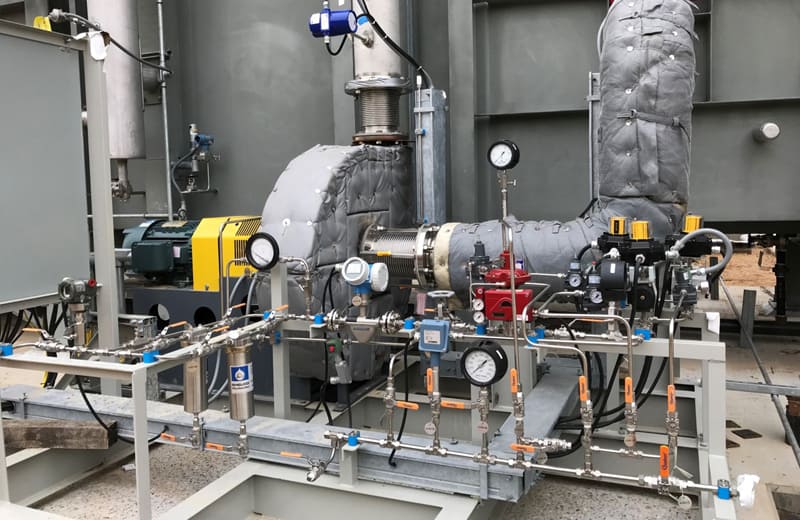Ammonia Direct Injection Removes NOx and CO from Gas Turbines
Jeff Wirt of EnergyLink International and Paul DiMascio of ProEnergy explain how their ammonia direct injection system and dual-use catalyst improves NOx reduction.
At POWERGEN 2025, Paul DiMascio, Chief Engineer at ProEnergy Services, and Jeff Wirt, Director of Catalyst Systems at EnergyLink International, led the session, Significant Findings from a Breakthrough in Gas Turbine NOx. As the industry attempts to comply with NOx emissions regulations, many OEMs are relying on conventional selective catalytic reduction (SCR) systems to achieve clean combustion.
The speakers presented an alternative technology: the direct ammonia injection system. According to an EnergyLink case study at Wattbridge Energy’s Braes Bayou facility, it eliminates the need for vaporization systems and injection grids.
Wirt emphasized the simplicity of EnergyLink’s demonstration: “We’re talking about a simple-cycle catalyst system—there’s no heat transfer involved. Just like you’d have on an automotive exhaust, you have a catalytic converter and a muffler; well, that’s what we’re doing with the muffler section located in the stack.”
The setup featured a gas turbine, which emitted exhaust gases that were distributed evenly via a distribution grid. From here, the exhaust was transferred through CO and an oxidation catalyst. According to Wirt, most non-methane and non-ethane hydrocarbons are oxidized in the CO catalyst, and downstream of these catalysts lies the ammonia injection grid.
Ammonia Injection Grid
“For NOx reduction, you need a reductant, and that reductant is ammonia, which delivers the missing link in the chemical process: a hydrogen atom,” said Wirt. “The tricky part is that ammonia isn’t safe to handle, so we dilute it with water down to 19% by weight. If we had put the ammonia downstream, the CO catalyst would oxidize all the ammonia into NOx, which is the exact opposite of what we want.”
Ammonia injection grid; image credit: EnergyLink International

The injection grid was moved forward in the flow stream behind the gas turbine’s exhaust duct. DiMascio said that, due to the high temperature of the exhaust gas and swirling motion, the diluted ammonia mixture immediately loses its water via evaporation, leaving only ammonia to mix with the gas stream.
“The advantages also lead to better effectiveness of the SCR system and the catalyst itself,” said DiMascio. “The ammonia is more uniformly distributed, and you can control the concentration even better. The new catalyst involved oxidizes the CO and NOx simultaneously, which is a new technology. This reduces the size of the ammonia injection grid and SCR, saving ProEnergy on CAPEX as we can make smaller foundations and reduce costs associated with shipping and onsite assembly.”
These advantages are but a few, with DiMascio outlining several more:
- Eliminates the ammonia vaporization skid
- Reduces stainless steel piping on exterior/interior of SCR
- Increases net power output
- Reduces ammonia fuel consumption
- Increases SCR efficiency
Project Background
In 2019, EnergyLink International approached ProEnergy to work on a simplified catalyst system, producing a concept for the ammonia injection grid as a backup system. “The Wattbridge Braes Bayou site is a 384-MW plant with eight gas turbines,” said DiMascio. “We worked together to figure out how we’d modify the foundation and where we’d place the SCR. Jeff’s team provided two skids so we could switch between direct injection and conventional on the same unit. We collected performance data from a precision performance test and reviewed the results.”
Before the pilot project, EnergyLink validated the proof-of-concept with computational fluid dynamics (CFD), but this process, according to Wirt, took far too long prior to testing. Instead, “We created a physical model to extradite the testing, with the ultimate goal of proving [the ammonia injection grid] in the field,” said Wirt. “In the fall of 2022, we conducted the test at Braes Bayou over the course of a week. We looked at different load conditions—full load and partial load—and we found that it worked very well.”
Results
The physical modeling, CFD, and in-field testing produced results that were better than expected, boasting a 5.8% and 5.3% root mean square, in which other systems/models would hover around 10%. Additionally, the overall footprint, installation labor, and CAPEX were reduced due to the system’s improved ammonia distribution. It also combined the two different sets of catalysts into one, eliminating traditional SCR infrastructure.
During the concluding Q&A, DiMascio claimed that the system applies to all gas turbines and may save over $100,000 per system. On a more technical note, the back pressure does not change following ammonia injection, and the injection lances are entirely removable, integrating flexibility into the design.
For more information on this session, view parts one and two of our video interview with DiMascio.